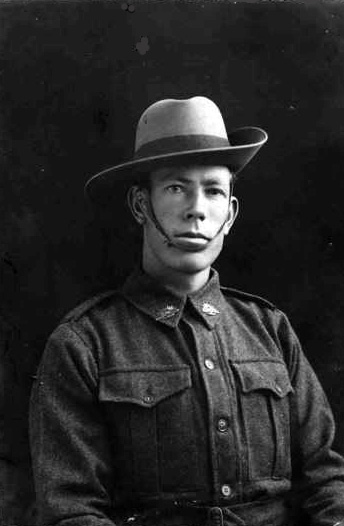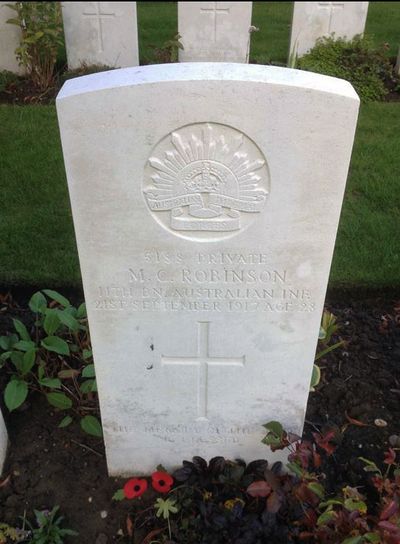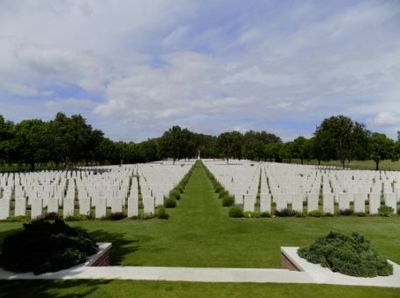Difference between revisions of "Maurice Clarence Robinson"
From Our Contribution
| Line 2: | Line 2: | ||
| image =[[File:Robinson_Maurice_Clarence.jpg|border|400px]] | | image =[[File:Robinson_Maurice_Clarence.jpg|border|400px]] | ||
| caption = Ancestry.com | | caption = Ancestry.com | ||
| − | | image2 =[[File:Robinson_Maurice_Clarence_headstone.jpg|border|]] | + | | image2 =[[File:Robinson_Maurice_Clarence_headstone.jpg|border|400px]] |
| caption2 = Ancestry.com | | caption2 = Ancestry.com | ||
| dateofbirth = ? Sep 1889 | | dateofbirth = ? Sep 1889 | ||
Revision as of 01:45, 15 September 2018
 Ancestry.com | |
 Ancestry.com | |
| Personal Information | |
|---|---|
| Date of Birth | ? Sep 1889 |
| Place of Birth | Serpentine, Western Australia |
| Death | 20 Sep 1917 |
| Place of Death | Glencorse Wood, near Zillebeke, Belgium |
| Age at Enlistment | 24 years |
| Description |
5'9" (1.75m) tall ; 140lbs 63.503 kg ; fair complexion ; grey eyes ; brown hair |
| Occupation | Miner |
| Religion | Roman Catholic |
| Address | North Dandalup, Western Australia |
| Next of Kin | Father , Mr Thomas Robinson |
| Military Information | |
| Reg Number | 5188 |
| Date of Enlistment | 4 Feb 1916 |
| Rank | Private |
| Unit/Formation | 11th Battalion, 16th Reinforcement posted to A Company |
| Date of Embarkation | 31 Mar 1916 ‒ 24 Apr 1916 |
| Ship Embarked On | HMAT A9 Shropshire Fremantle to Port Suez |
| Monument |
Keysbrook Roll of Honour Serpentine Roll of Honour Australian War Memorial |
| Medals |
British War Medal Victory Medal |
Contents
Pre War
Between 1896 and 13 Oct 1902 he attended schools in the Serpentine - Jarrahdale area.
Electoral Roll entry: Marrinup, sleeper cutter
War Service
Maurice3 entered camp on 4 Feb 1016, and on 14 Mar 1916 he was allocated to the 16th reinforcement draft for the 11th Battalion. Following their basic training in Australia they sailed to Egypt, where on arrival Maurice was sent to the 3rd Training Battalion.
On 31 Jul 1916 Maurice proceeded overseas to France, and on 2 Aug 1916 he entered the 1st Division's Base Depot in Étaples. On 12 Aug 1916 he and 49 others joined the 11th Battalion in the field at Bonneville where they were training and rebuilding after their involvement at Pozières, and preparatory to re-entering the front lines near Mouquet Farm. Maurice was seen by the Corps Collecting Station on 22 Aug 1916 suffering from shell shock (his records show WIA 20 - 25 Aug 1916). He was sent to the rest station for three days after which he rejoined the battalion on 25 Aug 1916.
Maurice was on 10 Oct 1916 charged with leaving a parade without permission, for which his punishment was 7 days Field punishment No.2 (see notes). On 17 Nov 1916 he was seen by the 5th Australian Field Ambulance and treated for Scabies. Transferred to the 39th Casualty Clearing Station on 20 Nov 1916, he was placed on an Ambulance Train on 23 Nov 1916 and sent to Camiers where he was admitted to the 20th General Hospital the next day. Cleared to return to duty on 27 Nov 1916 he was soon back in hospital on 1 Dec 1916 and this time, after nine days treatment he was sent to the Convalescent Depot on 10 Dec 1916. Released to duty again, he was readmitted to hospital on 18 Jan 1917, again with Scabies. He finally rejoined his unit on 7 Feb 1917 near Bazentin-le-petit. perhaps this is when he was moved from 'A' to 'C' Company.
On 20 Sep 1917 the 11th Battalion were part of an attack on German positions near the Menin Road. The 11th Battalion's objective being the capture of Glencorse Wood. At the completion of what had been a very successful attack, 40 men from the battalion were posted as missing including Maurice. A Court of Enquiry held on 27 May 1918 finally determined that Maurice had been killed in action on 21 Sep 1817. However, the statement below would place his death as having occurred don 20 Sep 1917 before, not after the attack.
The Australian War Memorial has a Red Cross File which contains the following statement by a collogue about the circumstances of his death:
"This was at Glencorse Wood, Ypres, on the morning of Sept. 20th, not 21st. We were waiting for our barrage to start before advancing, and Fritz put up his before ours began. Robinson and two or three more took shelter under a great pile of timber, and two or three shells landed on it blowing them all up in amongst the timber. There was no possibility of burial; they were all blown to small pieces. I know this for a fact because I tried to get into the timber myself with them, but got caught in the wire and couldn't." Robinson was in my Section, C.XII. His people live in North Dandalup, SW Railway, Bunbury Line. 5081A LCpl C.H. Parker, 12 Platoon, C Company, 11th Battalion.
On 30 Jan 1920 his parents were advised that his body was yet to be located. However, on 19 May 1920 his parents were advised that he now had an identified grave site, as enough of his remains had been identified with the aid of his cigarette case which contained a small note giving his name and unit. He was now able to be given a grave site.
Notes
Field punishment could be awarded by a court martial or a commanding officer for any offence committed on active service.
There were two categories of field punishment. Field Punishment No 1. required the soldier to be shackled to a wheel, a tree, or similar immovable object for several hours each day. Field punishment No. 2 consisted of heavy labouring duties, and spending several hours a day shackled . All offenders awarded field punishment would march with their unit, carry their arms and accoutrements, perform all their military duties as well as extra fatigue duties, and be treated as defaulters.

